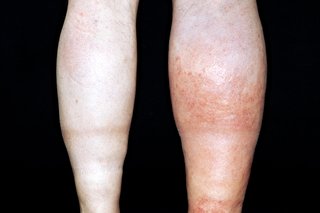Can You Feel a Blood Clot Move Up Your Leg
DVT (deep vein thrombosis) is a blood jell in a vein, usually the leg. DVT can be dangerous. Get medical help as soon equally possible if you lot think yous have DVT.
Urgent advice: Ask for an urgent GP appointment or get help from NHS 111 if:
You think you take DVT.
Symptoms of DVT in the leg are:
- throbbing or cramping hurting in 1 leg (rarely both legs), unremarkably in the calf or thigh
- swelling in ane leg (rarely both legs)
- warm peel around the painful area
- red or darkened skin around the painful area
- swollen veins that are hard or sore when you lot touch them
These symptoms can also happen in your arm or tummy if that'south where the blood clot is.
Y'all tin can call 111 or get help from 111 online.
What DVT in a leg can look like

Who is more likely to get DVT
A DVT is more likely to happen if you:
- are over 60
- are overweight
- smoke
- have had DVT earlier
- take the contraceptive pill or HRT
- have cancer or heart failure
- accept varicose veins
There are besides some temporary situations when you're at more risk of DVT. These include if you:
- are staying in or recently left hospital – especially if you cannot move effectually much (like later on an functioning)
- are confined to bed
- go on a long journey (more than than 3 hours) by plane, car or train
- are pregnant or if you've had a baby in the previous 6 weeks
- are dehydrated
Sometimes DVT can happen for no obvious reason.
How DVT is diagnosed
If a doctor thinks you have DVT, you should exist referred to hospital inside 24 hours for an ultrasound browse. The browse shows whether claret is flowing normally through the vein.
Y'all may also have an X-ray of the vein (venogram). For this, you volition be injected with a dye to show where the claret jell is.
Handling of DVT
You may have an injection of an anticoagulant (claret thinning) medicine called heparin while you're waiting for an ultrasound scan to tell if you lot have a DVT.
Later on DVT is diagnosed, the main treatment is tablets of an anticoagulant medicine, such as warfarin and rivaroxaban. Y'all will probably accept the tablets for at to the lowest degree 3 months.
If anticoagulant medicines are not suitable, you may have a filter put into a large vein – the vena cava – in your tummy. The filter traps and stops a blood clot travelling to your heart and lungs.
A newer treatment involves breaking up and sucking out the jell through a small tube in the vein. You unremarkably demand to have anticoagulant medicine for several months later this treatment.
DVT in pregnancy is treated differently. It is treated with anticoagulant injections for the rest of the pregnancy and until the baby is 6 weeks sometime. Read more most DVT in pregnancy.
Recovery from DVT
Some lifestyle measures will help y'all recover from DVT.
After y'all leave hospital, you will be encouraged to:
- walk regularly
- go on your affected leg raised when yous're sitting
- delay any flights or long journeys until at least two weeks after you beginning anticoagulant medicine
Tips to foreclose DVT
Do
-
stay a salubrious weight
-
stay agile – taking regular walks can assist
-
drinkable plenty of fluids to avoid aridity – DVT is more likely if y'all're dehydrated
Don't
-
do not sit still for long periods of time – get up and move effectually every hr or so
-
do not cross your legs while you're sitting, it can restrict blood menstruum
-
practice not smoke – get support to stop smoking
-
do not drink lots of booze
Going on a long journey
If you're travelling for 3 hours or more by plane, train or car, there are things you can do during the journey to reduce your hazard of DVT. These include drinking plenty of h2o and avoiding alcohol.
Find out more tips to reduce your take a chance of travel-related DVT
Going into hospital
If you go into hospital, your healthcare team should cheque your risks of DVT.
If they think you're more probable to get DVT, you may be given handling to prevent information technology, such as medicine or compression stockings (knee-loftier elastic socks that assist your claret circulation), while you're in hospital.
You lot may continue treatment later you exit hospital because a blood clot can happen weeks afterward.
Yous tin also help protect yourself against DVT while y'all're in hospital by:
- staying active and walking effectually if you tin
- moving your toes (up and down) and ankles (in circles) if you lot accept to stay in bed – your healthcare team may give you some exercises to do
Page last reviewed: 23 Oct 2019
Next review due: 23 October 2022
Source: https://www.nhs.uk/conditions/deep-vein-thrombosis-dvt/
0 Response to "Can You Feel a Blood Clot Move Up Your Leg"
Postar um comentário